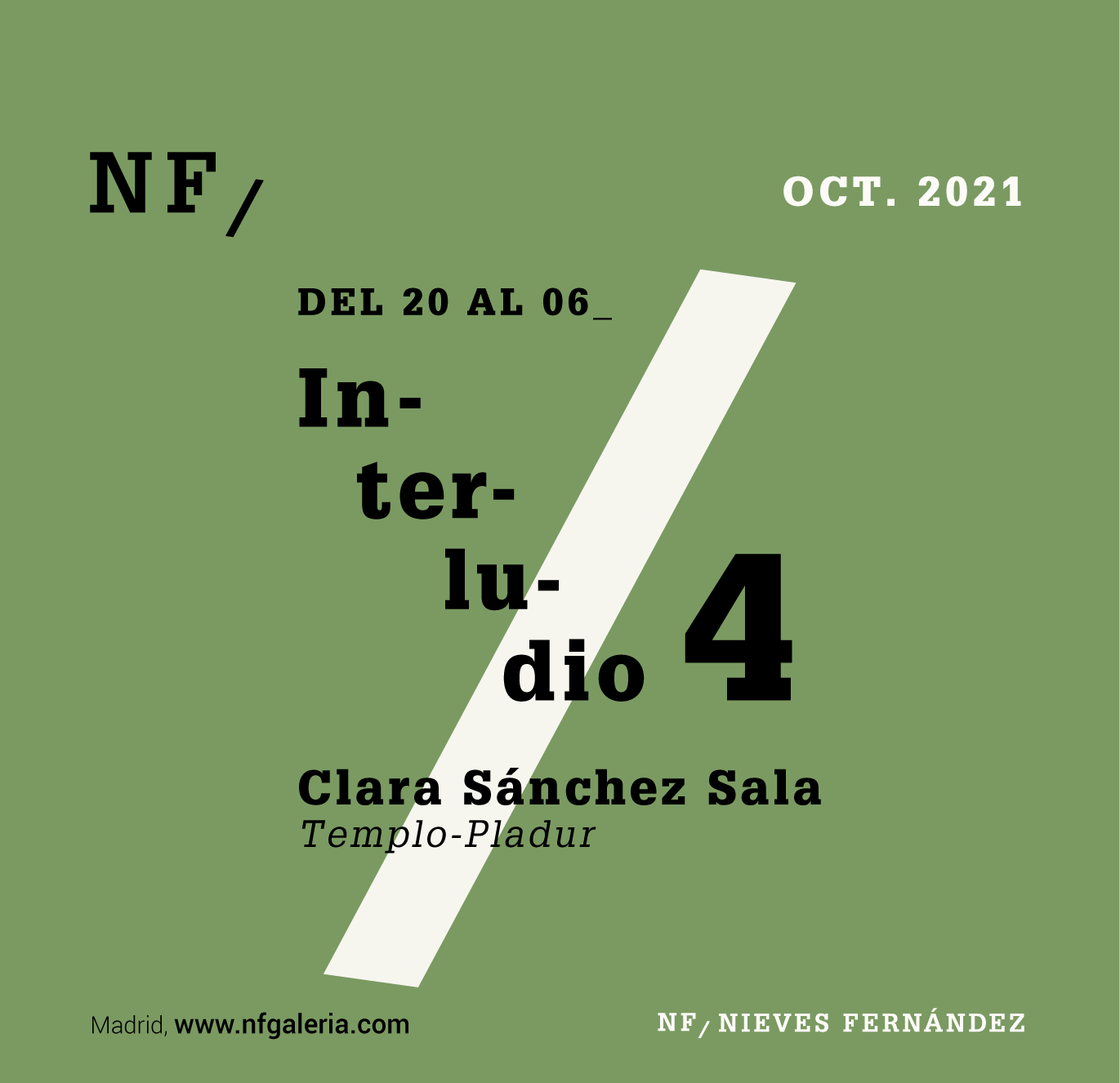
INTERLUDIO 4: TEMPLO-PLADUR. CLARA SÁNCHEZ SALA.
INAUGURACIÓN 20/OCT
The nude does not simply represent the body, but relates it, by analogy, to all structures
that have become part of our imaginative experience
[El desnudo no representa simplemente el cuerpo, sino que lo relaciona, por analogía, a todas
las estructuras que se han convertido en parte de nuestra experiencia imaginativa]
Kenneth Clark (1956)
Templo-Pladur genera un paralelismo entre la idea de inmortalidad presente en los desnudos de los dioses griegos con la de los espacios expositivos en el sentido en que se diseñan lugares donde las piezas parecen ser presentadas para la eternidad.
Constante y ancestral ha sido la relación entre la arquitectura y el cuerpo humano.
En la antigua Atenas parecía reinar una armonía entre la carne y la piedra, no solamente la disposición de los templos y las ciudades obedecía a la manera en que los griegos concebían el cuerpo humano, sino que habían convertido el desnudo en objeto de admiración.
Las figuras humanas del friso del Partenón muestran la desnudez de cuerpos jóvenes perfectos de una manera ultraterrenal, aludiendo así a una realidad inmortal. Esta experiencia visual que dignifica y heroiza se asemeja al descrito por Brian O ´Doherty en su ensayo Inside the White Cube: The ideology of the gallery space en el que interpreta el espacio de las galerías modernas como un lugar construido con el objetivo de generar al espectador la sensación de estar fuera del tiempo, o más allá de él. Como si la obra perteneciese ya a la posteridad, o estuviese en un limbo.
El título del proyecto hace referencia al edificio sagrado, pero también menciona el material de construcción utilizado actualmente para el revestimiento de techos y paredes con la intención no solamente de generar un desajuste temporal, sino también de poner en contacto la idea de desnudar o vestir arquitectónicamente las paredes de la galería. El espacio expositivo desnudo es tan perfecto como el cuerpo de los dioses griegos, las obras dispuestas parecen tan eternas como la carne dura de las esculturas que visten y arropan la arquitectura del lugar.
Templo-Pladur pone en contacto la arquitectura de las galerías de arte y los desnudos de los dioses griegos, tan irreales e imposibles que parecen vestidos de carne pétrea, a través del acto de vestir el espacio con obras de arte.
Templo-Pladur es la cuarta edición de Interludios, un conjunto de exposiciones de corta duración en NF/ NIEVES FERNÁNDEZ, cuya propuesta es generar un espacio de visibilidad para proyectos pensados por los artistas, representados o no por la galería, y que hasta entonces no se han podido realizar.
Clara Sánchez Sala (Alicante, 1987) es licenciada en Bellas Artes por la UCLM, Cuenca; Máster Photoespaña Teoría de la Fotografía y Proyectos Artísticos por la UEM, Madrid y Máster en Investigación en Arte y Creación por la UCM, Madrid. Ha participado en numerosas exposiciones tanto nacionales como internacionales entre las que destacan Fundación Juan March: Museo de Arte Abstracto, Cuenca; Centro de Arte Dos de Mayo, Madrid; Fundación Marso, Ciudad de México, México; Museu Nacional Soares Dos Reis, Oporto; Fundación Otazu, Pamplona; La Laboral, Gijón; EACC, Castellón y Centro Cultural Conde Duque, Madrid. Su obra forma de colecciones como DKV, CA2M y Fundación Otazu entre otras.
–
OPENING 20/OCT
The nude does not simply represent the body, but relates it, by analogy, to all structures
that have become part of our imaginative experience
Kenneth Clark (1956)
Templo-Pladur generates a parallel between the idea of immortality present in the nudes of the Greek gods with that of the exhibition spaces in the sense that places are designed where the pieces seem to be presented for eternity.
Constant and ancestral has been the relation between architecture and the human body.
In ancient Athens, a harmony between flesh and stone seemed to reign, not only the arrangement of temples and cities obeyed the way in which the Greeks conceived the human body, but they had turned nudity into an object of admiration.
The human figures in the Parthenon’s frieze show the nakedness of perfect young bodies in an unearthly way, thus alluding to an immortal reality. This visual experience that dignifies and heroizes is similar to that described by Brian O’Doherty in his essay Inside the White Cube: The ideology of the gallery space in which he interprets the space of modern galleries as a place built with the aim of generating the viewer the feeling of being outside of time, or beyond it. As if the work already belonged to posterity, or was in limbo.
The title of the project refers to the sacred building, but also mentions the construction material currently used for the cladding of ceilings and walls with the intention not only of generating a temporary mismatch, but also of putting in contact the idea of architectural undressing or dressing the gallery walls. The naked exhibition space is as perfect as the body of the Greek gods, the arranged works seem as eternal as the hard flesh of the sculptures that dress and cover the architecture of the place.
Templo-Pladur brings together the architecture of the art galleries and the nudes of the Greek gods, so unreal and impossible that they seem dressed in stony flesh, through the act of dressing the space with works of art.
Templo-Pladur is the fourth edition of Interludios, a set of short-term exhibitions at NF/ NIEVES FERNÁNDEZ, whose proposal is to create a visibility space for projects thought by the artists, whether or not represented by the gallery, and which until then have not have been possible.
Clara Sánchez Sala (Alicante, 1987) has a degree in Fine Arts from the UCLM, Cuenca; a Masters’ degree in Photoespaña Theory of Photography and Artistic Projects from the UEM, Madrid and a Masters in Research in Art and Creation from the UCM, Madrid. She has participated in numerous national and international exhibitions, among which at the Fundación Juan March: Museo de Arte Abstracto, Cuenca; Centro de Arte Dos de Mayo, Madrid; Fundación Marso, Mexico City, Mexico; Museu Nacional Soares Dos Reis, Porto; Fundación Otazu, Pamplona; La Laboral, Gijón; EACC, Castellón and Centro Cultural Conde Duque, Madrid. Her works belongs to collections such as DKV, CA2M and Fundación Otazu, among others.

